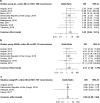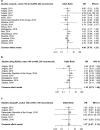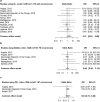Plasmodium falciparum multidrug resistance 1 gene polymorphisms associated with outcomes after anti-malarial treatment
- PMID: 40506728
- PMCID: PMC12160118
- DOI: 10.1186/s12936-025-05248-2
Plasmodium falciparum multidrug resistance 1 gene polymorphisms associated with outcomes after anti-malarial treatment
Abstract
Background: Plasmodium falciparum multidrug resistance transporter 1 (Pfmdr1) gene mutations are associated with altered response to artemisinin-based combination therapy (ACT), particularly the combinations containing the partner drugs lumefantrine and amodiaquine (i.e., artemether-lumefantrine [AL] and artesunate-amodiaquine [ASAQ]). Past studies of Pfmdr1 single nucleotide polymorphisms (SNPs) at codons 86, 184, and 1246 have shown different responses to AL and ASAQ.
Methods: To determine whether infection with parasites carrying specific Pfmdr1 SNPs leads to increased risk of recurrent parasitaemia (recrudescent or new infection), data from 3,915 samples from 16 therapeutic efficacy studies from 13 African countries between 2013 and 2019 were analysed.
Results: Patients treated with AL and infected with parasites carrying Pfmdr1 N86 were at greater risk of recurrent infection than those whose parasites carried 86Y. After treatment with ASAQ, individuals infected with parasites that carried Pfmdr1 86Y were more likely to experience a recurrent infection.
Conclusions: These results support prior studies that suggested: (1) patients given AL and infected with parasites carrying N86 were more likely to experience a recurrent infection; (2) patients given ASAQ and infected with parasites carrying 86Y were more likely to experience a recurrent infection. These findings suggest that ACT and Pfmdr1 genotype may influence outcome after Plasmodium falciparum infection.
Keywords: Plasmodium falciparum; Africa; Antimalarials; Drug resistance; Malaria.
© 2025. The Author(s).
Conflict of interest statement
Declarations. Disclaimer: The opinions expressed herein are those of the author(s) and do not necessarily reflect the views of any collaborating institute including the Centers for Disease Control and Prevention or the US Agency for International Development. Competing interests: The authors declare no competing interests.
Figures




References
-
- WHO Guidelines for malaria. Geneva: World Health Organization; 2024. https://www.who.int/publications/i/item/guidelines-for-malaria. Accessed 1 Jan 2025.
-
- WHO. World malaria report 2023. Geneva: World Health Organization; 2023.
-
- Rosenthal PJ, Asua V, Conrad MD. Emergence, transmission dynamics and mechanisms of artemisinin partial resistance in malaria parasites in Africa. Nat Rev Microbiol. 2024;22:373–84. - PubMed
-
- van der Pluijm RW, Imwong M, Chau NH, Hoa NT, Thuy-Nhien NT, Thanh NV, et al. Determinants of dihydroartemisinin-piperaquine treatment failure in Plasmodium falciparum malaria in Cambodia, Thailand, and Vietnam: a prospective clinical, pharmacological, and genetic study. Lancet Infect Dis. 2019;19:952–61. - PMC - PubMed
MeSH terms
Substances
LinkOut - more resources
Full Text Sources
Miscellaneous

